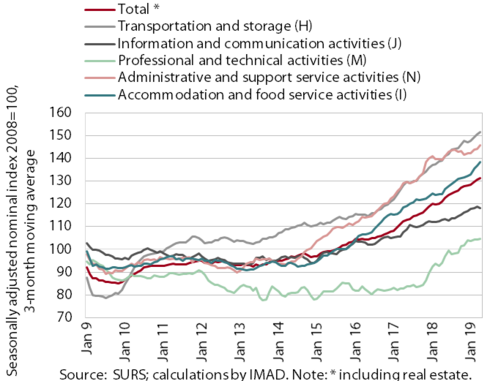Charts of the Week
Current Economic Trends from 24 to 28 June 2019: nominal turnover in market services, turnover in trade, prices and bond yields
At the beginning of the second quarter turnover growth remained high in most market services. Turnover in trade also remained high, but its real growth was more moderate than last year. In June inflation rose somewhat due to the higher year-on-year growth of prices of goods, but it is still mainly driven by higher prices of services.
Nominal turnover in market services (other than trade), April 2019

The growth of turnover in the majority of market services remained high at the beginning of the second quarter. In accommodation and food service activities, it accelerated slightly amid higher spending by both domestic and foreign guests. Higher growth was also recorded for turnover from the sale of services outsourced to external providers. This has been the main factor of further strong turnover growth in administrative and support service activities, amid a decline of turnover in employment services. The growth of turnover in more export-oriented services, such as road transport and computer services, remained high. With turnover in telecommunications services dropping for the third consecutive month, the growth of total turnover in information and communication activities came to a halt. Turnover in professional and technical activities has maintained the achieved level for several months.
Turnover in trade, April 2019

Turnover in trade remained high at the beginning of the second quarter; in the first four months it was more than a tenth higher year on year. This was a consequence of further growth in household consumption (particularly in the segments of household appliances and furniture, certain semi-durable goods, and also food products in recent months) and high sales of motor vehicles. Turnover in wholesale trade remained high as well, after last year’s acceleration, which had also been partly due to increased sales of some energy products.
Prices, June 2019

Year-on-year growth in consumer prices increased somewhat in June (1.8%). In addition to favourable economic conditions and rising household consumption, inflation continues to be largely driven by higher prices of services, particularly those related to housing, package holidays and restaurants and hotels. The increase in June’s inflation was to a large extent attributable to higher prices of goods, food in particular; the decline in clothing and footwear prices was also smaller than in previous years. Food prices, having largely been falling at the monthly level in past Junes, rose by 0.3% this June (the strongest monthly growth since 2001), which is related to less favourable weather conditions in the spring. The contribution of prices of oil products was negative, unlike in the previous two months.
Bond yields, Q2 2019

Yields to maturity of euro area government bonds dropped further in the second quarter. The decline was to a great extent due to the announcement of the introduction of additional expansionary monetary policy measures of the ECB. In most euro area countries bond yields thus dropped to, or close to, record lows. The yield to maturity of the Slovenian bond declined to 0.52% (down 43 basis points quarter on quarter), while the spread between the Slovenian and German bond yields narrowed notably after widening in the previous quarter.
